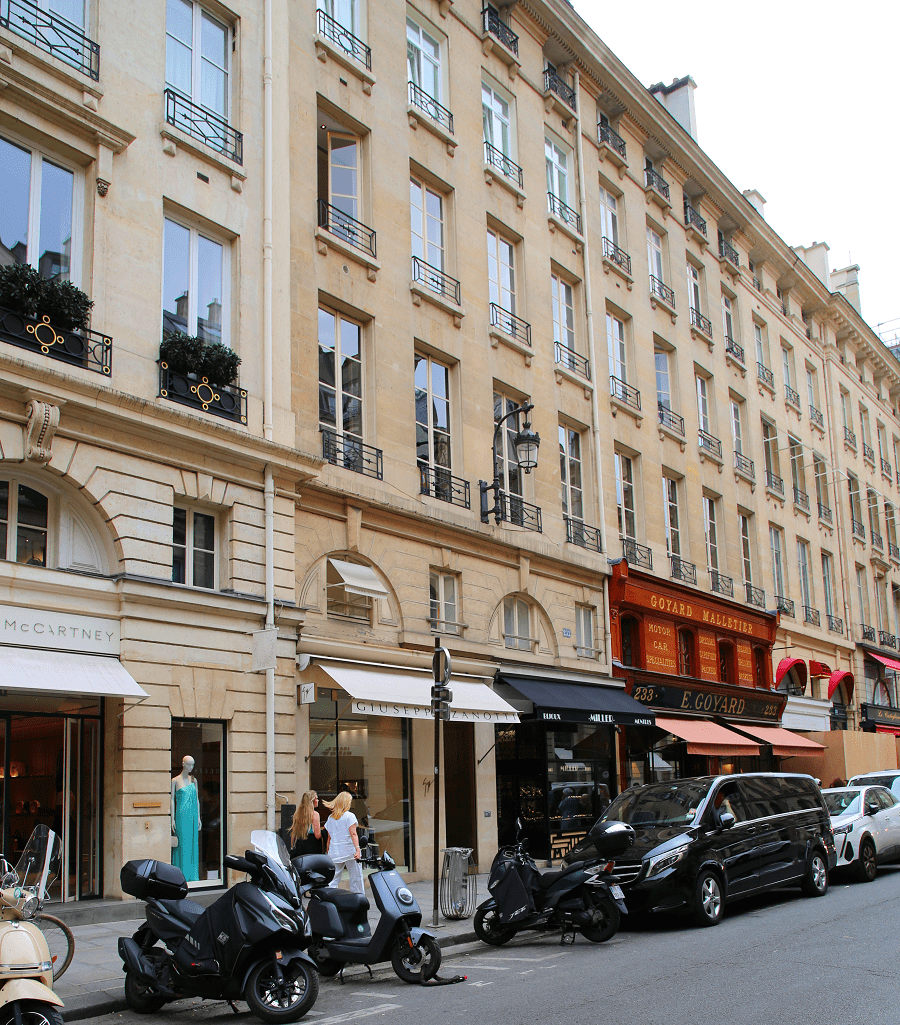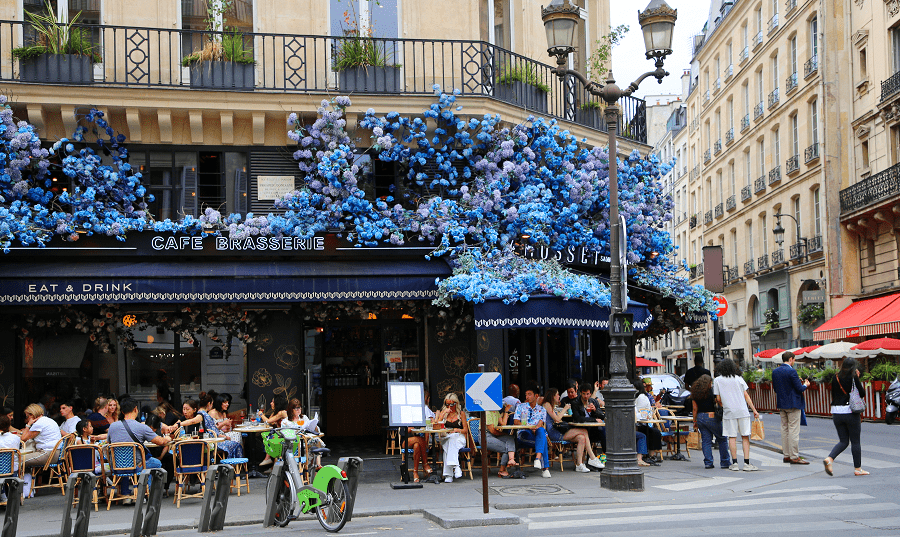Rue Saint-Honoré, located in the 1st and 8th arrondissements of Paris (France), is one of the longest streets in the capital. It connects Les Halles, to the east, to the Madeleine church to the west, via the Palais-Royal and Place-Vendôme districts.
It is 1,840 meters long, 20 meters wide over most of its route.
It provides access to several internationally renowned cultural sites (Louvre museum, Comédie-Française, Palais-Royal garden), public buildings where three of the four highest courts of the French Republic sit (Constitutional Council, Council of State, Court of Auditors), while being bordered by religious buildings of lesser notoriety (Louvre Oratory, Saint-Roch church, Notre-Dame-de-l’Assomption).
Main attractions
From rue des Halles to rue de l’Oratoire
No. 14: the scholar Claude Bernard moved into this house in 1863.
No. 19: the couple Marguerite Durand-Georges Laguerre lived there before their separation in 1891.
No. 22: from 1849, location of the central store of the Laborious and Fraternal Association of Shoemakers, a Fourierist-inspired cooperative.
No. 47: residence of Antoine de Lavoisier, eminent chemist but also Farmer General, who was for this reason, like all his colleagues, guillotined in 1794.
No. 60: headquarters of the Club des Prévoyants during the Revolution of 1848.
No. 75: residence of Napoléon Bazin, member of several republican secret societies, involved in the Quénisset attack against the Duke of Aumale, son of Louis-Philippe I, on his return from Algeria in 1841.
No. 82: residence of François Chabot, ex-Capuchin, author of the Catechism of the Sans-Culottes, deputy to the Convention, member of the General Security Committee, implicated for influence peddling in the Compagnie des Indes scandal, tried with Danton and guillotined on April 5, 1794.
No. 86: residence where Ranavalona III, the last queen in exile from Madagascar, stayed in June 1901.
No. 91: entrance to the village of Saint-Honoré, a small shopping plot where several art galleries and antique dealers are located. In 1976, Mila Parély ran the store that Jean Marais opened in Paris at 91, rue Saint-Honoré, under the name Jean Marais, potter, where he sold his pottery.
No. 96 (corner with rue Sauval): location of the Pavilion des Singes, house in which Molière was born on January 15, 1622.
No. 108: home of Jean-Jacques Pillot, member of the International Workers’ Association, signatory of the Red Poster, elected to the Commune in 1871.
No. 111: Croix-du-Trahoir crossroads, one of the busiest in Paris for centuries. The arrest of Pierre Broussel, advisor to the Parliament of Paris, took place there. It will constitute the starting point of the Fronde, on August 26, 1648.
No. 115: in 1762, Louis Claude Cadet de Gassicourt opened a pharmacy there. Jean-François Derosne and Charles Derosne trained as pharmacists there. The store still houses a pharmacy today.
No. 118: home of Jean-Baptiste Treilhard, member of the Committee of Public Safety and then director.
Nos. 121 to 125: location of the Hôtel d’Aligre or “Schomberg et d’Aligre”, a former private mansion from the 17th century (disappeared).
No. 123: location of the Aligre court where a public political meeting was held at the end of the Second Empire.
From rue de l’Oratoire to place André-Malraux
No. 145: the building of the Louvre Oratory was built astride the site of a section of the old rampart, leveled for this purpose in 1621, the year the first stone was laid.
Between nos. 146, 148 and 152: location of the first Saint-Honoré gate, built at the end of the 12th century and destroyed before the middle of the 16th century.
No. 151: the Louvre antiques shopping center, located in the former Louvre Department Stores.
Nos. 182 to 192: Bons-Enfants building, branch of the Ministry of Culture. The building on rue Saint-Honoré was built in 1919 by Georges Vaudoyer to house the reserves of the Grands Magasins du Louvre.
No 194: residence of Paul Barras in 1789.
No. 198: Garde-Meuble café. Home of Abbot Barbotin, deputy of the clergy to the Estates General.
No 202: one of the first rooms of the Paris Opera.
No 204: the Palais-Royal.
Between nos. 155 and 161: location, from 1260 to 1779, of the former Quinze-Vingts hospice founded by Louis IX to shelter 300 poor blind people.
No. 155: Louvre hotel. The Delamain bookstore, founded in 1700 under the arcades of the Comédie Française, transferred here in 1906, is the oldest active Parisian bookstore.
No. 157: opened in 1716, the tobacco shop À la civette is the oldest in operation in Paris.
No. 161: Moroccan National Tourism Office. It occupies the former Café de la Régence, closed in 1910.
In 1815, at the start of the Restoration, it was the scene of numerous clashes between demobilized Napoleonic officers and royalist officers.
From Place André-Malraux to Rue Saint-Roch
No. 161: location in 1380 of the Saint-Honoré gate of the enclosure of Charles V; second gate of this name, also known as the Blind Gate.
No. 173: headquarters of the newspaper Le Canard enchaîné in which microphones installed by the DST were discovered on December 3, 1973, leading to the plumbers affair.
No. 177: north exit of the former Delorme gallery (south exit at no. 188, rue de Rivoli) built by the architect Vestier
No. 181: the architect, decorator and painter Louis Süe and his associate, the painter André Mare, carried out the layout of the Fontaine et Cie store in 1921.
No. 185: residence of Alexandre Dumase between 1864 and 1866.
No. 195: birthplace of Félix Tournachon, who took the pseudonym Nadar (born April 6, 1820).
No. 203 (current 199): Trois-Pigeons inn where Ravaillac stayed on May 13, 1610, the day before the assassination of Henri IV.
No. 209: residence and office of Doctor Joseph Ignace Guillotin after the Revolution. He was a great humanist and one of the main drafters of the Declaration of the Rights of Man and of the Citizen.
No. 214: headquarters of the Free Men club during the Revolution of 1848.
No. 216: office of Alexandre Dumas Sr. from 1823 to 1830.
No. 219: headquarters of the Club des Bureaucrates during the Revolution of 1848.
Between No. 229 and 235: location of the Feuillants convent where Jean de La Fontaine lived for a while, hosted by Marguerite Hessein de la Sablière, known as Mme de La Sablière in 1673.
No. 239: first living room of Louise d’Épinay, known as Mme d’Épinay, near the Capuchin cemetery. Famous salon where artists and philosophers of the Enlightenment met, from 1748 to 1762.
No. 245: former headquarters of the Lenthéric house, founded in 1885.
No. 247: workshops of Augustin Henry-Lepaute since 1829, famous watchmaker manufacturer of clocks for public buildings which equipped many train stations and town halls in the 19th century.
No. 251: building (1930) housing the Mandarin Oriental Paris hotel since 2011.
No. 254: residence of Pierre-Toussaint Durand de Maillane, known as “Durand-Maillane”, one of the spokespersons for the Plain at the Convention.
No. 261: location of the very renowned and luxurious Voisin café-restaurant which hit the headlines during the siege of Paris in 1870 by presenting antelope, camel and elephant on the menu on December 25.
No. 263: convent of the Ladies of the Assumption where certain ladies of the court retired under the Ancien Régime.
No. 270: residence of Marie Olympe Grouze, known as Olympe de Gouges. Feminist who wrote the Declaration of the Rights of Women and Citizens in 1791.
No. 272: home of Marc Vadier, mountain deputy, member of the General Security Committee.
No. 273: residence of the former abbot Emmanuel Joseph Sieyès, whom Robespierre nicknamed “the mole of the Revolution”.
No. 284: residence of Marquis Louis de Fontanes, poet friend of François-René de Chateaubriand, in 1800.
No. 286: Saint-Roch church.
From rue Saint-Roch to rue Royale
No. 300 and 302: Lyon d’Or inn, on the northwest corner with rue Saint-Roch.
No. 308: house rented by Mme de La Sablière to Jean de La Fontaine in 1685.
Nos. 310 to 316: residence of the Spanish composer Juan Crisóstomo de Arriaga.
No. 315: residence of Joseph Fouché, Duke of Otranto, Minister of Police of several regimes.
No. 317: residence of the constitutional bishop Claude Fauchet, deputy to the Convention, founder of the newspaper La Bouche de fer, guillotined with the Girondins.
No. 319: residence of Nicolas François de Neufchâteau, deputy in the Legislative Assembly.
No. 320: residence of Bertrand Barère de Vieuzac, member of the Committee of Public Safety.
No. 332: the Peruvian painter Herman Braun-Vega lived and worked at this address between 1968 and 1972.
No 334: small hotel in Noailles, residence of Marivaux in 1744.
No 335: Egerton Hotel.
No. 338: former headquarters of the Soupé et Pierrugues house, which manufactured wine bottles for Emperor Napoleon I.
No. 339: home of Jean Antoine Debry, author of an essay on national education.
No. 343: residence of Antoine-Adrien Lamourette, constitutional bishop of Lyon.
No. 357: home of the engineer Achille Chaper during the Restoration.
No. 359: headquarters of the Club of political convicts in 1848.
No. 367: Saint-Hyacinthe chapel of the Assomption convent, seat of the Democratic Club of Freethinkers in 1848.
No. 368: residence of Jean Maximilien Lamarque.
No. 370: home of Jeanne Poisson, Marquise de Pompadour.
No. 374: salon of Marie-Thérèse Rodet Geoffrin, known as Mme Geoffrin, who, with her daughter Marie-Thérèse de La Ferté-Imbault, brings together Fontenelle, Montesquieu, Voltaire, Grimm, d’Alembert, Helvétius, Marmontel, d’Holbach , Diderot, Hume, from 1749 to 1777.
No. 374: residence of François-René de Chateaubriand, minister under the Restoration, in 1825.
No. 377: residence of Jean-Paul Rabaut de Saint-Étienne, known as Rabaut Saint-Étienne, a Girondist conventionalist who proposed including freedom of conscience in the Declaration of Rights.
No. 397: address where Honoré de Balzac located the perfumery La Reine des roses, by César Birotteau, which went bankrupt in 1819.
No. 398: home of the carpenter Maurice Duplay (then 366, rue Saint-Honoré), who hosted Maximilien Robespierre from 1791 to 1794.
No. 422: location of the Saint-Honoré gate of the enclosure of Louis XIII, built in 1634 and destroyed in 1773.
See more:


























